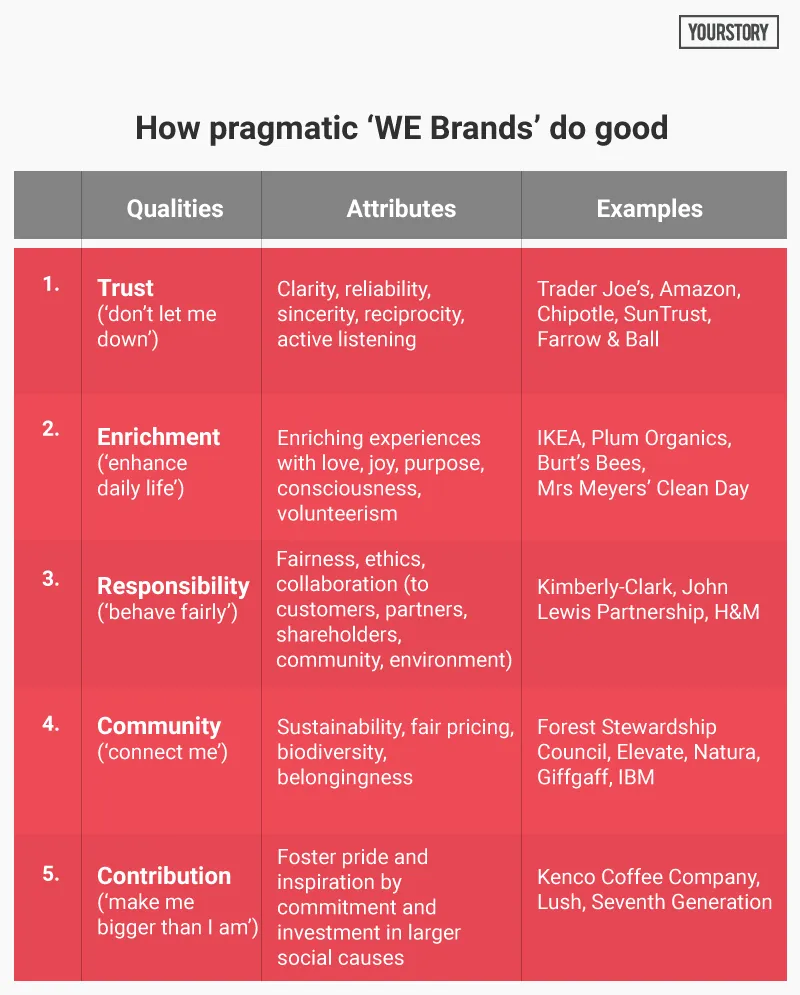Do good: 5 steps for companies to become profitable as well as socially responsible
Can business profitability co-exist with broader purpose? This book presents a five-step framework for why and how companies should do good and not just do well in the market.

Empowered by social media, people of all ages want to see, track and monitor how companies engage in fair employment practices, social responsibility, and charitable giving. They want to see how companies do good and not just look good by bolting on cosmetic changes or marketing ploys.
The thoroughly-researched 300-page book Do Good: Embracing Brand Citizenship to Fuel Both Purpose and Profit shows why and how companies need to embed social consciousness into the brand DNA. In Table 1, I have summarised the author’s five-step model, based on trust (deliver on promises), enrichment (make daily life easier or more inspiring), responsibility (treat people and the environment with respect), community (mirror the values shared by customers, employees, partners) and contribution (make a difference in the world).
Anne Bahr Thompson is founder of OneSixtyFourth, a boutique consultancy that integrates cultural shifts and a social conscience into brand development. She was formerly head of consulting at Interbrand, and has more than 25 years experience as a global brand strategist. She holds an MBA from the Darden Graduate School at the University of Virginia.
By actively linking great brands with higher purposes, companies can capture both markets and hearts, says Anne. Without sacrificing profits, companies can incorporate social missions into their brands and create tangible social impact. Companies today need solid business models as well as stronger value models.
See also my reviews of the related books A World of Three Zeros (Muhammad Yunus), Frugal Innovation (Navi Radjou and Jaideep Prabhu), and A Beautiful Constraint (Adam Morgan and Mark Barden). Anne cites a number of useful books and online resources as well: Emotional Branding (Marc Gobe), Lovemarks (Kevin Roberts), Charity Navigator, and Transparency Index (for the fashion sector). Active organisations in this space include B Lab (for B Corp certification or ‘benefit corporation’), Business Roundtable, Natural Products Association, and Responsible Business Network.
I. Do good: drivers and examples
“Brand Citizenship is a way of doing business that people trust, believe in, and rely on. It creates a sense of partnership and belonging,” Ann defines. It cuts across core purpose, delivery processes and engagement with employees and customers. Consumers today want to see companies cultivating a larger sense of purpose by giving back to society and making the world a better place.
The term ‘brand’ is not just about quality, features, selection, price, design, convenience, durability or value – its meaning has expanded over the years into social and environmental responsibility as well, via connection to a larger community or grander mission. Companies are expected to show commitment to ethical sourcing, CSR, charitable giving, equitable supplier relationships, investor transparency, clear communication, and fair employee policies.
Brand citizenship helps companies focus not just on personal ‘me’ problems but also broader ‘we’ concerns about the world. Companies that are seen as more of ‘me’ brands are Walmart and Apple, whereas ‘we’ brands focusing on the greater good are Google and Microsoft (including the Gates Foundation), according to Anne.
A number of companies have contributed to this growing momentum of conscious capitalism. For example, Toms grew into a $600 million company by giving away 35 million pair of shoes as matching donations. Nike has designed FlyEase shoes that are easier to wear for people with disabilities; it is also embracing renewable energy and recyclable materials, and publishes an annual Sustainable Business Report.
Unilever partnered with Direct Relief to provide Vaseline Jelly to refuges in conflict zones. Metrics tracked programme participation and awareness along with brand reappraisal and business growth.
II. The five-step framework
The book presents a five-step framework for organisations to progress from ‘me’ to ‘we’ brands (see summary in Table 1 below: trust, enrichment, responsibility, community, contribution). Dozens of case studies show how these principles look in action.

Business leaders need to articulate their vision and drive, so as to enhance customer connect and loyalty. The “tone at the top” by leaders is not just about quarterly results but also long-term value creation. Overall wellness and wellbeing are as important as value and valuation.
- Trust
When it comes to trust, consumers expect companies to do good, but not necessarily be perfect. Errors and mistakes may be made, but companies should be sincere in admitting guilt and taking corrective action, eg. food poisoning in Chipotle’s restaurants.
Trader Joe offers a curated selection along with a sense of humour and fun; it also has signage created by local artists. Its employees are called Crew Members, Merchants, Mates and Captains.
Zappos is also legendary for its customer service and happy-employee culture. Amazon is leveraging customer analytics to better identify their needs and aspirations, but can do more to be a “benevolent friend, not just a boundless entity.” (Interestingly, Zappos has been acquired by Amazon.)
Farrow&Ball, maker of wallpapers, has a blog called The Chromatologist where experts and customers offer decoration tips. SunTrust offers financial literacy programmes to the underserved.
Walmart wants to run on 100 percent renewable energy, create zero waste, and sell products that sustain resources, better lives and the environment. Concrete steps include switching to LED lights, a target of zero waste to landfills by 2025, stopping sales of military-style semi-automatic weapons, sourcing from women-owned businesses, and supporting the dignity of workers in the supply chain.
- Enrichment
Brand purpose extends from vision right down to the product or service’s look and feel, quality standards, and user communications. Startups may face challenges in retaining their brand promise when they are acquired by giant firms, but must make sure they stay true to their brand mission.
For example, Mrs Meyers cleaning products are made of naturally derived ingredients, do not use animal testing, and even have an artisanal feel. It takes part in planting and artistic activities.
The products of Burt’s Bees prioritise responsible trade and animal rights. Plum Organics promotes “nutritional intelligence,” and has launched an accelerator for wellness food brands for children; it also partnered with the Convoy of Hope to donate baby meals in disaster areas.
IKEA has cultivated a conscious, learning culture. It has worked with UNICEF to ensure that child labour is not practiced in its global chains, and has published a code of conduct for its suppliers. It aims to have “circular capabilities” by 2030 for all its products, in terms of recycling, restoration and reuse.
- Responsibility
Companies may be increasingly pressured to declare their political leanings and points of view on social justice and civil liberties – this calls for a “fine line” on brand activism, cautions Anne. This can include pledges to environmental preservation, marriage equality, and employee welfare.
For example, Kimberly-Clark set goals like zero workplace fatalities, zero manufacturing waste to landfills, and reduction in packaging impact. It also aligned with the Andrex Toilets Change Lives programme for sanitation rights, and contributes to accelerators working with sanitation entrepreneurs.
The John Lewis Partnership innovates for the future by creating the JLab accelerator for startups in digital commerce, e-learning and health. Waitrose commits to greener energy and farming systems via freshness guarantees.
H&M has started recycling old clothing materials to make new clothes; it aims to make “fashion sustainable and sustainability fashionable.” The company supports the circular fashion movement and garment worker rights, and has partnered with the company Conscious Commerce to promote conscious consumerism.
Anne explains that consumers also play a key role in this regard; people should change their own behaviours to show commitment to communities, rights and the environment in their consumption patterns. In that sense, brand transformation is a journey of collaboration and co-creation.
- Community
Companies need to engage with local and global communities – online as well as offline. Consumers want to connect to like-minded people and to aspirational goals. Brands must facilitate (not own) communities and enhance (not control) conversations, Anne advises.
For example, the Forest Stewardship Council aims to preserve forests by creating forest certification schemes for manufactured products. The MVNO Giffgaff in the UK crowdsources tech support and suggestions for improvement; it has expanded to micro-lending services.
IBM revitalised itself by conducting a Values Jam and Innovation Jam to redefine its commitment to individuals, customers and business excellence; it now offers jam-based consulting services to clients. The Elevate Network, originally formed as an alumni group of Goldman Sachs women, offers mentorship, support and networking events for women entrepreneurs; it has created the Women Index Fund.
Brazilian cosmetics firm Natura promotes humanism, balance, transparency and creativity; it adopts practices like product refills to reduce packaging costs, support for forest researchers, and sourcing from eco-innovators.
- Contribution
“WE brands are not angry or radical activists,” Anne explains; they are for-profit pragmatists who show commitment to a moral compass through transformative actions and inspirational messaging.
For example, beauty products firm Lush commits to not do testing on animals; it promotes handmade products and naked packaging. Its Charity Pot lotion is used to fund humanitarian and regenerative community projects.
Seventh Generation promotes long-term thinking seven generations down the road (inspired by Native American lore); its cleaning products list all ingredients, and are sustainably produced. It wants business to transform from “engines of destruction to instruments of regeneration.” One percent of employee time goes to community service. The company also has a social venture fund, and has acquired companies like Bobble (reusable filtered water bottles).
Kenco Coffee Company has partnered with the Rainforest Alliance to source beans from certified farms, and with TerraCycle to reuse old packaging. It also invests in training farm entrepreneurs.
III. The road ahead
“Business is a social and cultural institution as much as it is a source of economic prosperity,” Anne explains. The brand citizenship journey begins with a clearly defined brand purpose, which draws on organisational heritage, stakeholder expectations, and core competencies.
The purpose must be mapped onto operating principles covering the five categories of brand citizenship. The levels of maturity along this curve include Pioneer, Active Contributor, Self-server and Pretender. The journey down this road is iterative and experimental, and may be full of setbacks and mistakes.
The transformation to a WE brand will eventually involve all departments: product development, marketing, finance, HR, customer relations, SCM, legal, digital/IT, sustainability, and CSR. “Brand citizenship is a journey, not an endgame,” says Anne.
In sum, in an era of rapid global change and increasing business complexity, the book provides companies a broad framework with practical steps to calibrate their progress in brand loyalty, leadership and corporate citizenship.
The book is a must-read for leaders of established businesses as well as founders of emerging startups. Most of the case studies in the book feature US and European companies, but the book opens the door for similar research to be conducted in other regions as well.
Being pragmatic and profitable no longer need to be incompatible with idealism and altruism, but the journey is continuously evolving as social realities and expectations change. “People are seeking brands that both enrich their lives and better society,” sums up Anne.







